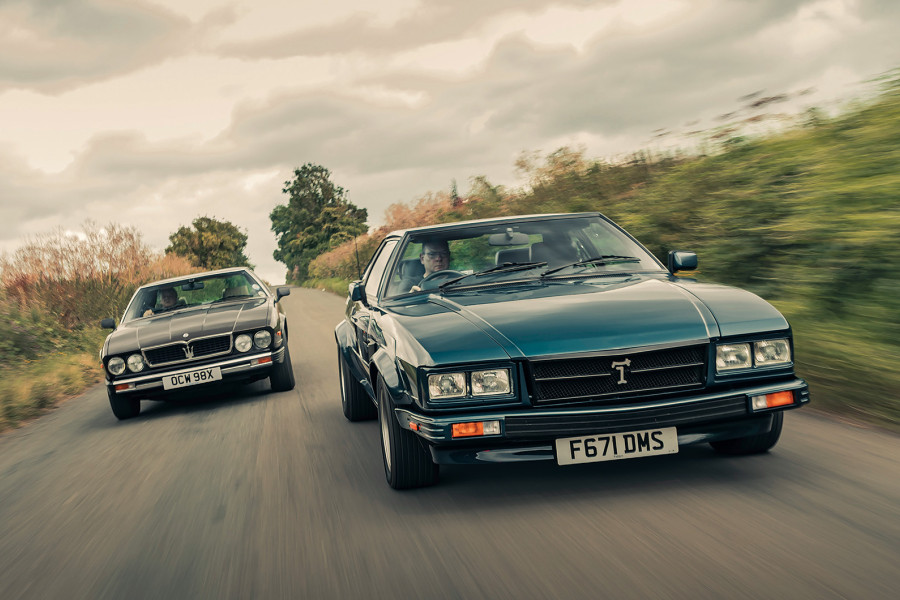Today the car carries Fangio’s famous number 4 and Castrol sponsorship from that final São Paulo win.
The victory impressed Brazilian playboy Severino Gómez-Silva, who made an offer that Giambertone couldn’t refuse.
Although an enthusiastic racer with his 200S, Gómez-Silva preferred to take the 300S out along the Copacabana Beach to impress the ladies.
Through various Brazilian owners right up to 1972, chassis 3069 continued to be raced locally, but you’d never recognise it because the gorgeous original aluminium bodywork was replaced by a rather different, boxy design – and was incongruously repainted yellow.
It is claimed that the four-wheel drum brakes stopped as well as early discs
The Maserati eventually went into storage until 1979, when it was discovered by legendary car hunter Colin Crabbe on one of his many sleuthing trips to South America.
A deal was done for $7000 and 3069, stripped of its yellow body, was shipped to the workshop of Antique Automobiles in Baston, on the edge of the Fens.
Historic racer Chris Drake eventually had 3069 fully restored with a new body, and by 1988 it was back in Italy where Count Zanon entered it in the 1988 Mille Miglia Storica.
The longer-stroke 3-litre engine delivers more torque compared to the 250F
After passing through the hands of a series of well-known collectors and historic racers – including Massimo Columbo, Michel Seydoux and Lord Irvine Laidlaw – 3069 was sold in 1999 to Scottish-born American William Binnie.
A highly experienced racer in both moderns and historics, including three Le Mans sorties, Binnie loved racing the 300S.
Over the following 20 years he ticked all the premier event boxes including the Mille Miglia, Le Mans Classic, Goodwood Revival and the much-missed Shell Historic Ferrari Maserati Challenge.
The 300S remains one of my all-time favourite sports-racers and, although a cold, misty winter’s day on the Fens couldn’t be much further removed from that hot summer Lisbon weekend in 1957, the chance to drive one of the 26 Trident beauties is enough excitement to stop me sleeping the night before.
Chassis 3069 passed through the hands of some prolific collectors and historic racers
The reason this late-development 300S is now temporarily based in East Anglia is for fettling by Steve Hart, a leading Maserati specialist, for dealer Fiskens.
Walking into Hart’s Norfolk workshop is a treat for any fan of historic racing, but particularly admirers of the golden years of Orsi-era Maseratis. As well as three more examples of the 300S including 3067, which also ended up in Brazil with a modified yellow body, there’s a clutch of 250Fs in various stages of work.
It was the restoration of Hart’s first 300S back in 1991, while working for historic racing specialist Neil Twyman, that kick-started a love affair with post-war racing Maseratis.
‘The performance and sound of this 780kg rocket are awesome’
More than 30 years ago Hart took me for a test drive around a Hertfordshire industrial estate in the ex-works 300S ‘3056/3077’, and the sound as we drifted around roundabouts on a summer evening left an indelible memory.
As well as a respected specialist, Hart is also an impressive driver. “Like a lot of things, I’ve learnt to love them,” enthuses Hart. “Everything about the design and construction is beautiful – you can tell the factory mechanics were very proud of their work.
“The 300S is really well designed, too: the deep chassis has great stiffness and, thanks to the transaxle, the weight balance is perfect.
“With the original set-up of soft springs and stiff Houdaille dampers it’s a lovely thing to drive, particularly at my favourite tracks, Spa and Dijon.”
Fangio dominated in the 1957 Brazilian Grand Prix © Fiskens
Frustratingly, the increased development of Jaguar-powered ’50s sports-racers has deterred 300S owners from racing them, and even on the Mille Miglia retrospective they are rarely seen.
Only by driving a 300S do you get to appreciate its greatness, so maybe it’s time the Goodwood Revival staged a Supercortemaggiore-style grid for 1950s Maseratis, Ferraris and Oscas to lure them back to the track.
Had I millions to indulge, I’d be knocking at the door of Fiskens’ London mews showroom.
Images: Tim Scott/Fluid Images
Thanks to: Gregor Fisken; Steve Hart; historian Walter Bäumer, author of the definitive book on the Maserati 300S published by Dalton Watson
READ MORE
Welcome to the jet set: Ferrari 365GT 2+2 vs Maserati Mexico vs Monteverdi 375L
Tackling the Mille Miglia in a Blower Bentley
Ferrari 250 Testa Rossa: Refined to perfection
Mick Walsh
Mick Walsh is Classic & Sports Car’s International Editor



























